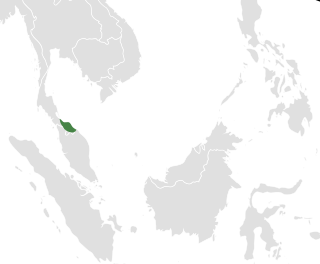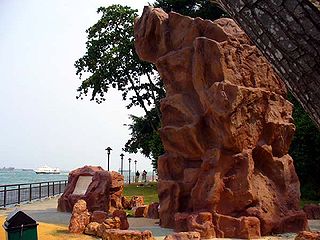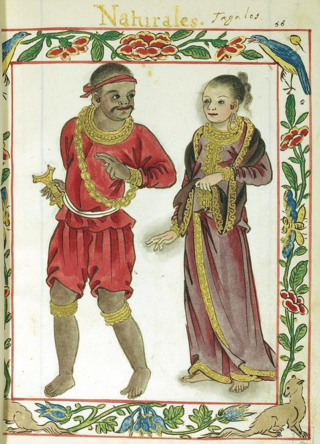
Incense is an aromatic biotic material that releases fragrant smoke when burnt. The term is used for either the material or the aroma. Incense is used for aesthetic reasons, religious worship, aromatherapy, meditation, and ceremony. It may also be used as a simple deodorant or insect repellent.

Sandalwood is a class of woods from trees in the genus Santalum. The woods are heavy, yellow, and fine-grained, and, unlike many other aromatic woods, they retain their fragrance for decades. Sandalwood oil is extracted from the woods. Sandalwood is often cited as one of the most expensive woods in the world. Both the wood and the oil produce a distinctive fragrance that has been highly valued for centuries. Consequently, some species of these slow-growing trees have suffered over-harvesting in the past.

Temasek is an early recorded name of a settlement on the site of modern Singapore. The name appears in early Malay and Javanese literature, and it is also recorded in Yuan and Ming Chinese documents as Danmaxi. Two distinct settlements were recorded in Temasek – Long Ya Men and Ban Zu. The name is used in modern-day Singapore for national honours as well as institutions and corporations.

Langkasuka was an ancient Hindu-Buddhist kingdom located in the Malay Peninsula. Langkasuka flourished from the 200's to the 1500's as the oldest kingdom in the Malay Peninsula, believed to have been established by descendants of Ashoka the Great. The name is Sanskrit in origin; it is thought to be a combination of langkha for "resplendent land" -sukkha for "bliss". The kingdom, along with Old Kedah, is among the earliest kingdoms founded on the Malay Peninsula. The exact location of the kingdom is of some debate, but archaeological discoveries at Yarang near Pattani, Thailand suggest a probable location. The kingdom is proposed to have been established in the 1st century, perhaps between 80 and 100 AD.

The Port of Singapore is the collection of facilities and terminals that conduct maritime trade and handle Singapore's harbours and shipping. It has been ranked as the top maritime capital of the world, since 2015. Currently the world's second-busiest port in terms of total shipping tonnage, it also transships a fifth of the world's shipping containers, half of the world's annual supply of crude oil, and is the world's busiest transshipment port. It was also the busiest port in terms of total cargo tonnage handled until 2010, when it was surpassed by the Port of Shanghai.

Agarwood, aloeswood, eaglewood, gharuwood or the Wood of Gods, most commonly referred to as oud or oudh, is a fragrant, dark and resinous wood used in incense, perfume, and small hand carvings. It forms in the heartwood of Aquilaria trees after they become infected with a type of Phaeoacremonium mold, P. parasitica. The tree defensively secretes a resin to combat the fungal infestation. Prior to becoming infected, the heartwood mostly lacks scent, and is relatively light and pale in colouration. However, as the infection advances and the tree produces its fragrant resin as a final option of defense, the heartwood becomes very dense, dark, and saturated with resin. This product is harvested, and most famously referred to in cosmetics under the scent names of oud, oodh or aguru; however, it is also called aloes, agar, as well as gaharu or jinko. With thousands of years of known use, and valued across Muslim, Christian, and Hindu communities, oud is prized in Middle Eastern and South Asian cultures for its distinctive fragrance, utilized in colognes, incense and perfumes.

Rosewood is any of a number of richly hued hardwoods, often brownish with darker veining, but found in other colours. It is hard, tough, strong, and dense. True rosewoods come from trees of the genus Dalbergia, but other woods are often called rosewood. Rosewood takes a high polish and is used for luxury furniture-making, flooring, musical instruments, and turnery.

The incense clock is a timekeeping device that originated from China during the Song Dynasty (960–1279) and spread to neighboring East Asian countries such as Japan and Korea. The clocks' bodies are effectively specialized censers that hold incense sticks or powdered incense that have been manufactured and calibrated to a known rate of combustion, used to measure minutes, hours, or days. The clock may also contain bells and gongs which act as strikers. Although the water clock and astronomical clock were known in China, incense clocks were commonly used at homes and temples in dynastic times.
Zi Teng is a non-governmental organisation that cares about the basic rights of women who live in Hong Kong and those who came from mainland China, especially sex workers. Ziteng is formed by social workers, women studies researchers, church workers and labour activists, etc.

Long Ya Men or Dragon's Teeth Gate, is the name Chinese explorer Wang Dayuan recorded for Batu Belayar, a craggy granite outcrop that formerly stood at the gateway to Keppel Harbour in Singapore. In his description, “The strait runs between the two hills of the Danmaxi (Temasek) natives which looked like dragon’s teeth.” From there, the name Long Ya Men or Dragon Teeth’s Gate was born.

Incense in China is traditionally used in a wide range of Chinese cultural activities including religious ceremonies, ancestor veneration, traditional medicine, and in daily life. Known as xiang, incense was used by the Chinese cultures starting from Neolithic times with it coming to greater prominence starting from the Xia, Shang, and Zhou dynasties.

Ma-i, or Maidh, was an ancient sovereign state located in what is now the Philippines.
Daoyi Zhilüe or Daoyi Zhi which may be translated as A Brief Account of Island Barbarians or other similar titles, is a book written c. 1339 by Yuan dynasty Chinese traveller Wang Dayuan recounting his travels to over a hundred places in South Asia, Southeast Asia, and Africa. The book was written in present-day Sri Lanka. It described the weather, products, people, and customs of the places that Wang Dayuan visited.

Acronychia pedunculata is a large shrub or small tree of the understory, gaps and fringes of low country and lower hill tropical forests of tropical Asia.

The Kingdom of Singapura was a Malay Hindu-Buddhist kingdom thought to have been established during the early history of Singapore upon its main island Temasek from 1299 until its fall sometime between 1396 and 1398. Conventional view marks c. 1299 as the founding year of the kingdom by Sang Nila Utama, whose father is Sang Sapurba, a semi-divine figure who according to legend is the ancestor of several Malay monarchs in the Malay World.

Lamuri, Lamri, or Lambri was a kingdom in northern Sumatra, Indonesia recorded from the 9th century until the early 16th century. The area was inhabited by Hindu population around the seventh century. There is also evidence of Buddhism. The region is also thought to be one of the earliest places of arrival of Islam in the Indonesian archipelago, and in its later period its rulers were Muslims.

Zhu Fan Zhi, variously translated as A Description of Barbarian Nations, Records of Foreign People, or other similar titles, is a 13th-century Song Dynasty work by Zhao Rukuo. The work is a collection of descriptions of countries and various products from outside China, and it is considered an important source of information on the people, customs and in particular the traded commodities of many countries in South East Asia and around the Indian Ocean during the Song Dynasty.

Lingwai Daida, variously translated as Representative Answers from the Region beyond the Mountains, Notes Answering [Curious Questions] from the land beyond the Pass or other similar titles, is a 12th-century geographical treatise written by Zhou Qufei. It contains information on the geography, history, social custom and economy of territories of southern China, Guangxi in particular. More significantly it also provides knowledge of distant lands in China during the Song dynasty, and includes descriptions of oversea states as far away as Africa and southern Spain.

Ban Zu or Banzu was a port settlement believed to have thrived in Singapore during the 14th century. It is proposed to be located on Fort Canning Hill and the area on the north bank of the Singapore River basin between the hill and the sea. It was mentioned by the Chinese traveller Wang Dayuan in his work Daoyi Zhilüe together with Long Ya Men as the two settlements that made up Temasek. It may have been abandoned before 1400 after an attack by either the Siamese or the Majapahit.
Dalbergia parviflora is a species of liana found in South East Asia. Its name is kayu laka in Malay and Indonesian, from which the word lakawood, the heartwood of the plant used for incense, is derived.
















